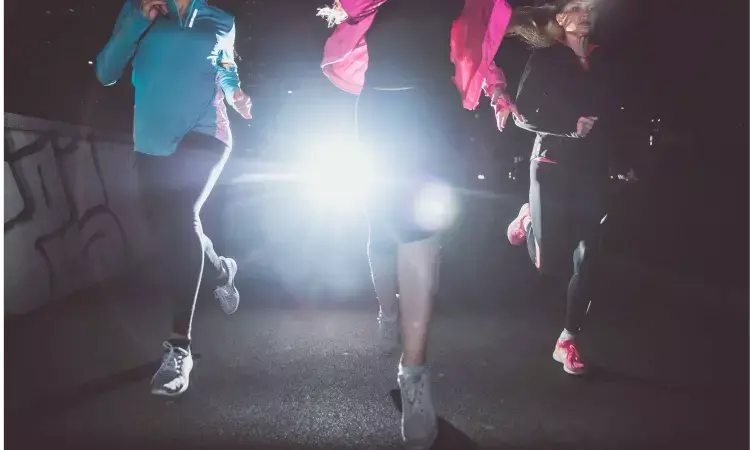- Home
- Medical news & Guidelines
- Anesthesiology
- Cardiology and CTVS
- Critical Care
- Dentistry
- Dermatology
- Diabetes and Endocrinology
- ENT
- Gastroenterology
- Medicine
- Nephrology
- Neurology
- Obstretics-Gynaecology
- Oncology
- Ophthalmology
- Orthopaedics
- Pediatrics-Neonatology
- Psychiatry
- Pulmonology
- Radiology
- Surgery
- Urology
- Laboratory Medicine
- Diet
- Nursing
- Paramedical
- Physiotherapy
- Health news
- Fact Check
- Bone Health Fact Check
- Brain Health Fact Check
- Cancer Related Fact Check
- Child Care Fact Check
- Dental and oral health fact check
- Diabetes and metabolic health fact check
- Diet and Nutrition Fact Check
- Eye and ENT Care Fact Check
- Fitness fact check
- Gut health fact check
- Heart health fact check
- Kidney health fact check
- Medical education fact check
- Men's health fact check
- Respiratory fact check
- Skin and hair care fact check
- Vaccine and Immunization fact check
- Women's health fact check
- AYUSH
- State News
- Andaman and Nicobar Islands
- Andhra Pradesh
- Arunachal Pradesh
- Assam
- Bihar
- Chandigarh
- Chattisgarh
- Dadra and Nagar Haveli
- Daman and Diu
- Delhi
- Goa
- Gujarat
- Haryana
- Himachal Pradesh
- Jammu & Kashmir
- Jharkhand
- Karnataka
- Kerala
- Ladakh
- Lakshadweep
- Madhya Pradesh
- Maharashtra
- Manipur
- Meghalaya
- Mizoram
- Nagaland
- Odisha
- Puducherry
- Punjab
- Rajasthan
- Sikkim
- Tamil Nadu
- Telangana
- Tripura
- Uttar Pradesh
- Uttrakhand
- West Bengal
- Medical Education
- Industry
Outdoor Artificial light exposure associated with increased Metabolic Syndrome risk

Researchers recently acknowledged outdoor ALAN as an indicator of urbanization. A recent ten-city study on more than 100,000 middle-aged and elderly Chinese has demonstrated an association between outdoor ALAN and increased risk of metabolic syndrome, particularly in males, elderly aged ≥65 years, and urban, low-activity populations. The odds of metabolic syndrome or MetS associated with ALAN were smaller in those living with higher grass and tree cover.
Metabolic syndrome is characterised by high fasting blood glucose (FG), high triglyceride (TG), low high-density lipoprotein cholesterol (HDL-C), high blood pressure (BP), and obesity. This first human study on ALAN and metabolic syndrome was published in Ecotoxicology and Environmental Safety.
This study, “Association of Outdoor Artificial Light at Night with Metabolic Syndrome and the Modifying Effect of Tree and Grass Cover,” is led by Yi et al. and colleagues.
ALAN is linked to metabolic hazards, but its association with MetS remains unclear. This association was studied in 109,452 participants living in 10 cities in eastern China. At baseline, 4395 participants without MetS were followed up.
Generalized linear models and Stratified analyses were performed. The key results could be summarised as:
- Compared to the first quantile (Q1) of outdoor ALAN exposure, the odds ratios in the third and fourth quantiles (Q3, Q4) of outdoor ALAN exposure were 1.156 and 1.073, respectively.
- The OR of MetS in Q4 of ALAN exposure was 1.204.
- They also found Adverse associations of ALAN with MetS components (high FG, high TG, and obesity).
- The association was more significant in males, the elderly, urban residents, low physical activity, and those living in areas with low grass and tree cover levels.
The strengths of the present study are the big sample size and collected comprehensive information on putative covariates.
They acknowledged the study’s limitations as inherent limitations in providing evidence on a causal relationship between ALAN and MetS, limited follow-up, evaluation of outdoor ALAN exposure only through satellite data, non-consideration of Indoor ALAN exposure and exposure time, inability to consider some covariates like dietary habits, family history of chronic diseases, and use of light protection, non-consideration of previous smoking or drinking behaviours, inclusion of only two types of green space and exposure measurement bias.
They noted, “There is an association between outdoor ALAN exposure and the odds of MetS. They found this association stronger in males, elderly, urban residents, lack of physical activity, and those living in areas with less grass and tree cover.
Future studies are warranted to investigate this association.
The National Natural Science Foundation of China funded the study.
Further reading:
https://www.sciencedirect.com/science/article/pii/S0147651323009569
BDS, MDS in Periodontics and Implantology
Dr. Aditi Yadav is a BDS, MDS in Periodontics and Implantology. She has a clinical experience of 5 years as a laser dental surgeon. She also has a Diploma in clinical research and pharmacovigilance and is a Certified data scientist. She is currently working as a content developer in e-health services. Dr. Yadav has a keen interest in Medical Journalism and is actively involved in Medical Research writing.
Dr Kamal Kant Kohli-MBBS, DTCD- a chest specialist with more than 30 years of practice and a flair for writing clinical articles, Dr Kamal Kant Kohli joined Medical Dialogues as a Chief Editor of Medical News. Besides writing articles, as an editor, he proofreads and verifies all the medical content published on Medical Dialogues including those coming from journals, studies,medical conferences,guidelines etc. Email: drkohli@medicaldialogues.in. Contact no. 011-43720751


